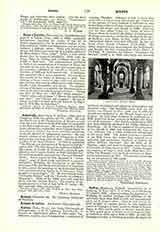

Rolduc (RODA Ducts, also Roda, Closterroda or Hertogenrade), in S. E. Limburg, Netherlands. It became an Augustinian abbey in 1104 under Ven. Ailbertus, a priest, son of Ammoricus, a nobleman of Antoing, Flanders. Ailbertus is said to have been guided by a vision towards this chosen spot, which was in the domain of Count Adelbert of Saffenberch, who, before Bishop Othert of Liege, turned over the property destined for abbey and church in 1108. Ailbertus was the first abbot (1104-11). Later he went to France where he founded the Abbey of Clairfontaine. Desiring once more to see Rolduc, he died on the way, at Sechtem, near Bonn, 19 Sep., 1122 (Acta SS.). Thirty-eight abbots succeeded Ailbertus, the last one being Peter Joseph Chaineux (1779-1800). The abbey acquired many possessions in the Netherlands, and became the last resting-place of the Dukes of Limburg. It possesses the famous “Catalogus Librorum”, made A.D. 1230, containing one hundred and forty theological and eighty-six philosophical and classical works. The beautiful crypt, built by Ailbertus, was blessed December 13, 1106, and in 1108 the church was dedicated to the Blessed Virgin and St. Gabriel. In 1122 Pope Calixtus II confirmed by a Bull, preserved in the archives of Rolduc, the donation of the property. The church, completed in 1209, was then solemnly dedicated by Philip, Bishop of Ratzeburg. Dr. R. Corten completed the restoration of the church in 1893, and transferred the relics of Ven. Ailbertus into a richly sculptured sarcophagus in the crypt, 1897. The church possesses a particle of the Holy Cross, five inches long, reputed to be authentic and miraculous (Archives of Rolduc, by Abbot Mathias Amezaga); also the body of St. Daphne, virgin and martyr, brought over from the Catacombs of Praetextatus in 1847. Rolduc became the seminary of Liege in 1831, under Right Rev. Cornelius Van Bommel, and the little seminary of Roermond, and academy in 1841. The present institution has an attendance of 420 pupils.
THEOPHILE STENMANS

